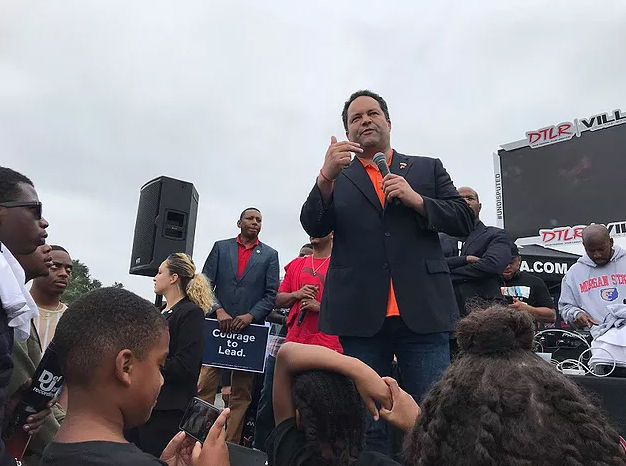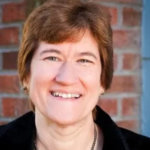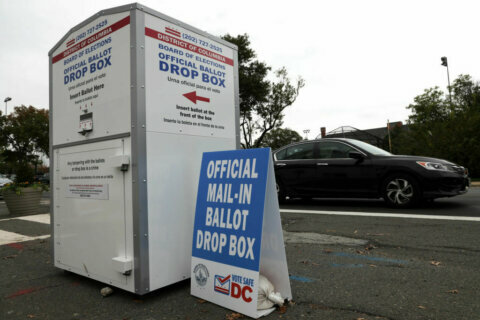This article was republished with permission from WTOP’s news partners at Maryland Matters. Sign up for Maryland Matters’ free email subscription today.
By Bob Guldin
When Donald Trump unexpectedly won the 2016 presidential election, a lot of Maryland progressives were appalled and shocked into action. Thousands demonstrated on the streets of Washington, D.C., sent money to liberal causes, formed new “resistance” groups overnight, and took to Facebook, email and Twitter to express their anger and dismay.
But experienced political observers asked, “Is this anger going to blow over, or will it translate into real changes in the next election?”
Maryland Matters has been checking in with these left-leaning “resistance” groups around the state, and the answer seems to be: they’re fired up and in full campaign mode.

The Maryland Blue Wave
While in most states the “Blue Wave” is just an optimistic expression of Democratic hopes, in Maryland it’s an actual organization. The Maryland Blue Wave Coalition brings together the state Democratic Party, Indivisible chapters in Montgomery, Towson and Howard County, Together We Will, Do the Most Good, Progressive Maryland, the gubernatorial campaign of Benjamin T. Jealous (D), and Our Revolution – about 30 groups in all.
Typical of these progressive groups is their eagerness to work in varying coalitions. For example, before the June primary election, four of them – Progressive Maryland, Progressive Neighbors, Our Revolution and Democratic Socialists of America – put out a joint voters’ guide spotlighting preferred candidates.
Cecilia Plante of Olney, a Blue Wave organizer, says almost all the grass-roots work is done by local groups. A kickoff rally in Rockville on Sept. 15 drew 600 people. Another big event will feature house parties across the state on Oct. 11, with Jealous on TV talking about Medicare for all. “He actually gets to talk policy, instead of sound bites,” Plante says.
An important figure in building the Blue Wave has been U.S. Rep. Jamie Raskin, an energetic progressive Democrat. For the past three years, Raskin has sponsored a youth training program called Democracy Summer. Last summer, more than 175 young people went through training in all aspects of campaigning, not only in Silver Spring, but also in Des Moines, Iowa, Charlottesville, Va., and Philadelphia. Then, Raskin says, “they were deployed into swing House districts, many in Pennsylvania and Virginia.”
Because he does not face formidable opposition in November, Raskin says, “In 2018, I decided to throw my resources into Democracy Summer. We have been working around the clock to build the big Blue Wave.”
Persistently upbeat, Raskin adds, “I’ve never seen anything like this level of intensity. All of that outdoor protest energy has been channeled into the electoral component.”
Women Power
Ever since the 2016 election, it’s been clear that women are playing a leading role in all parts of the anti-Trump resistance.
Cecilia Plante of the Blue Wave Coalition says it plainly: “The resistance is female.” Working in a statewide coalition, she notes that “the preponderance of group leaders are women.”
Raskin agrees: “All these groups are women-funded and women-run.”
Barbara Nouveau of Do the Most Good says that at a boot camp her organization held, “90 percent of the participants and all of the organizers were women. The movement is mostly educated white women from their 30s to their 60s. They have the skills, the financial wherewithal. Plus, it’s been driven by the #MeToo movement. It’s just part of the phenomenon.”
And with the Brett M. Kavanaugh nomination to the Supreme Court having raised tempers to the boiling point, it’s very likely that those motivated women will stay motivated through Election Day.
Playing to their Strengths
Recognizing that Maryland’s grass-roots progressives tend to have certain strengths, resistance leaders and their Democratic Party partners have focused on using volunteers in citizen outreach. The most common activities are participating in phone banks and door-to-door canvassing. Activities requiring special skills and contacts – like fundraising, planning TV ad campaigns, and managing the candidates’ websites – are usually left to professionals.
Many efforts are coordinated through JWalkers, a small but important group in Bethesda that functions almost like a command post coordinating efforts for the Blue Wave. Jon Heintz, a leading member, says the group draws on grass-roots groups like Do the Most Good and Raskin’s Democracy Summer to get phone calling and canvassing done. About 10,000 volunteers in all have taken part. Among its favorite current candidates: Georgia gubernatorial candidate Stacey Abrams; Texas Rep. Beto O’Rourke, who is challenging Sen. Ted Cruz (R); Marc Elrich for county executive in Montgomery County; and Jealous, who has enthusiastic support from Democratic progressives even if some of the party establishment is wary.
Given the persistently unfavorable poll numbers for Jealous, much of the effort for the gubernatorial candidate is on increasing voter turnout. “That’s the game we’re in,” says Heintz.
A decade ago, most political commentators seemed certain that the future of campaigning lay in the Internet and its many apps. So it’s significant that so much energy in 2018 is being put into tools that are decidedly old school. Not just the telephone and door to door canvassing, but postcards, which are being hand-written by volunteers and sent out by the thousands to voters.
“We need to use the Internet as an organizing tool, but it will never take the place of face-to-face conversation,” Raskin observes. However, resistance groups this year are making more use of one-on-one text messages, which can be given an individual touch and are more likely to get attention than phone calls from unknown callers.
Democrats and Leftists
Getting Democrats and people to the left of mainstream Democrats (whether they call themselves socialists, left-leaning or progressives) to work together is not always easy. The 2016 primary race between Hillary Clinton and Bernie Sanders showed that clearly. So how is the sometimes uneasy alliance between the Democratic Party and its progressive wing playing out in the current campaign season?
Short answer: It depends.
Some groups, like Do the Most Good, Democracy Summer and JWalkers, are completely loyal to the party.
Barbara Nouveau, a leader of Do the Most Good, concedes that “the Democratic Party is not cutting-edge resistance.” But she says, “The party in Maryland has moved strongly to the left. That has to do in large part with Donald Trump. Kathleen Matthews, the Maryland party chair, has created an opening for progressives, too. And the electorate on the Democratic side is pushing the party to the left.”
Besides, says Nouveau, “the tension is a little good. It keeps the party on their toes.”
More leftist groups in the resistance, like Progressive Maryland and Our Revolution, tend to keep a greater distance from the party. “But they are recognizing that the Democratic Party is not all bad,” Nouveau says. For example, progressives are working enthusiastically to elect Jealous.
Larry Stafford, the executive director of Progressive Maryland, confirms, “Our top priority is Ben Jealous. We’re not exclusively aligned with the Democratic Party; we’re not a friend of the Democratic Party establishment. But we’re glad to work with anybody who wants to get Ben elected.”
Democratic activist Sheila Ruth
On a practical level, state Democratic parties have a sophisticated database, the Voter Action Network, that they make available to allied organizations. And the campaigns themselves sometimes pick up the costs for phone banking and texting.

Sheila Ruth from Baltimore County is a member of the Maryland Democratic Central Committee officially representing the party’s progressive wing. She says, “Some issues, like Medicare for all, have become mainstream,” and that helps the party’s factions pull together.
Ruth predicts that some big issues in the next state legislative term, like the fight for a $15 minimum wage and moving toward 100 percent clean energy, will help keep Democrats unified.
“Nobody is wearing Bernie or Hillary buttons now,” she says.
Bob Guldin is a freelance writer based in Takoma Park.







